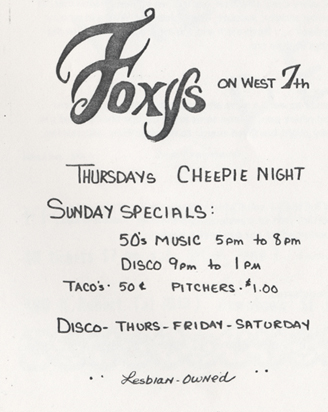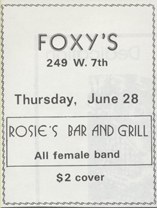Foxy's Bar
249 West Seventh Street, St. Paul
| Foxy's Ad from the 1979 Twin Cities Pride Guide. Courtesy of the Jean-Nickolaus Tretter Collection. |
Foxy’s Bar was a popular neighborhood bar and night spot for queer women who settled in the West Seventh Neighborhood of St. Paul. Women likely chose West Seventh--formerly a neighborhood of Eastern European immigrants(1)--because it was the safest neighborhood for its price with easy access to downtown St. Paul’s jobs.
|
Once a socially acceptable location for women to live together, the large district stretched from the old seven corners area (roughly the site of the Xcel Energy Center), north to the Cathedral, towards the Minnesota State Capitol and Central Park, and east to Broadway Street. Sadly, postwar ideas regarding marriage and child rearing removed the social support for female households.
 Foxy's Ad from the 1978 "Lesbian" Twin Cities Pride Guide. Courtesy of the Jean-Nickolaus Tretter Collection. |
At the same time, plans for the Minnesota State Capitol Grounds, Interstate 94, and Interstate 35E demolished much of the old apartment district where female couples used to live. Without other affordable options close to their workplaces, determined women (or women with the luxury of choice) settled along West Seventh Street and established a separatist lesbian community.(3)
|
(1) Caperton-Halvorson. Newcomer's Handbook for Moving to and Living in Minneapolis - St. Paul NEw York: Firstbooks,com, 2006. Page 65.
(2) Sigerman, Harriet. The Columbia Documentary History of American Women Since 1941. Ney York: Columbia University Press, 2003. Page 336.
(3) Tretter, Jean-Nickolaus. Interview with the author and Jacob Gentz. 1/16/09
(4) Klauda, Ann. "Foxy's to Close, Owners Open Castle Royal" Equal Time, issue 64, 9/19/1984
(5) Curnoyer, Nancy. Interview with the author and Jacob Gentz. March, 2009.
(6) Douma, Greatchen. "New bars Expand St. Paul Nightlife" Equal Time, issue 90, 9/18/1985.
Part of Minneapolis/St. Paul, MN: 100 Queer Places in Minnesota History, (1860-1969), (1969-2010)
